How to Brake on a Bicycle
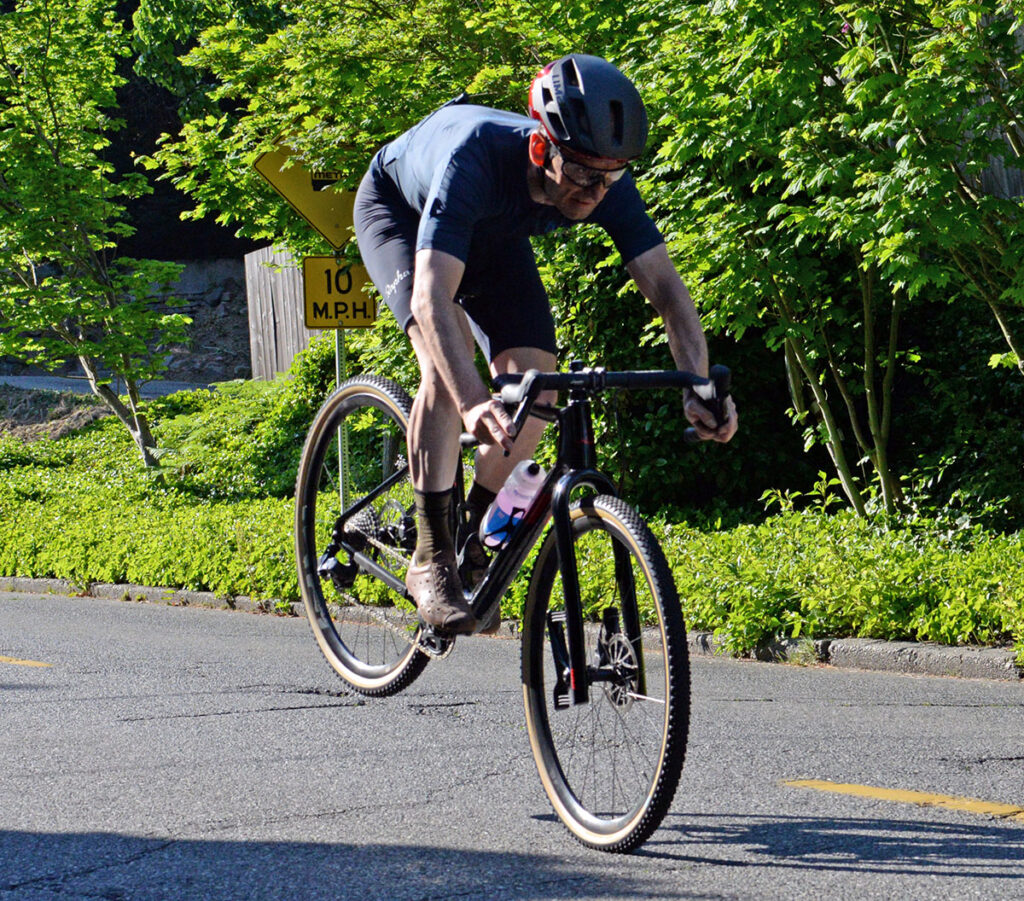
Whether you ride fast or slow, being able to stop quickly is an important skill. Your ability to stop also depends on how well your brakes perform. In Bicycle Quarterly 37, we tested brake performance to determine:
- How do you brake most effectively?
- Do brakes with different stopping power affect braking distances?
- Do brake shoes and pads make a big difference?
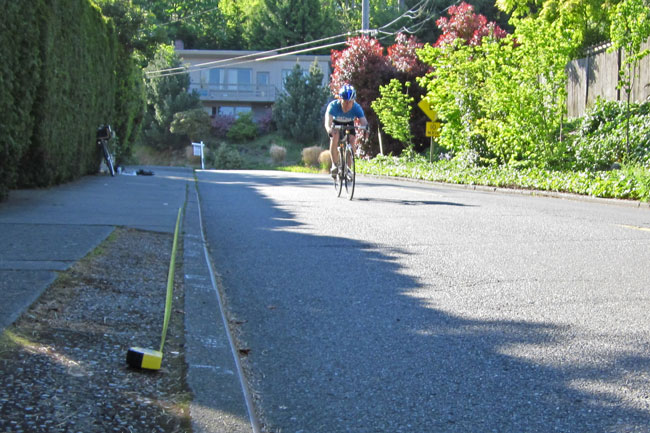
For this test, we coasted from a set point down a steep hill (always using the same riding position), and then braked at a predetermined point. Two testers performed the tests, to differentiate the “rider” factor in brake performance.
Why test on a downhill? The stopping distance on a hill is longer, and thus the differences between brakes and techniques are more pronounced. Afterward, we performed a statistical analysis to evaluate whether we were measuring real differences in braking performance and not just seeing noise in the data.
This test confirmed quite a few things about effective braking technique:
Front vs. Rear Brake
On dry pavement, the front brake alone halts the bike over the shortest distance. Many riders think they need both brakes to stop effectively. (Most bikes are outfitted with two brakes and that implies that one should use both.) Here’s the way to think about it: the momentum of your body continues to move forward as your bike is slowing down, so your weight shifts forward. That’s why your rear wheel can come off the ground when braking hard. When your weight comes forward during hard braking, your rear wheel has almost zero traction. If you apply the rear brake under these conditions, the rear wheel will lock up without contributing significantly to the braking effort.
If you can apply the rear brake without locking up the rear wheel, then your weight isn’t shifting forward – you aren’t braking as hard as you should!
We tried braking with both brakes and with the front brake alone, and consistently found that if we focused all our attention on the front brake, we achieved much shorter stopping distances.
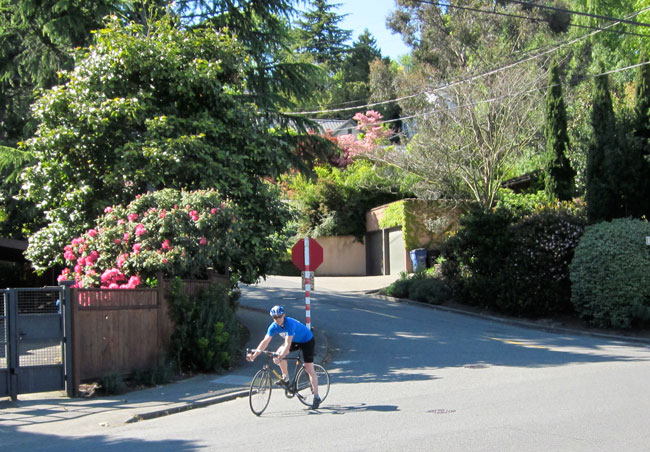
When we braked with the rear brake only, the stopping distance was more than three times as long. In fact, our tester overshot the stop sign and went into the road at the bottom of the hill (above). This was despite modulating the rear brake carefully to keep it below the lockup point as much as possible. Skidding the wheel would have increased the stopping distance further.
Why do bikes have rear brakes at all? The rear brake comes in handy when it is so slippery that even moderate braking will lock up your wheels – when you encounter ice, wet leaves, loose gravel, or other very slippery pavement during the first rain after a long dry spell. Under these conditions, you cannot brake hard, and the forward weight transfer is much less pronounced. In that case, the rear brake provides added braking that slows you more quickly. Rear brakes also are useful on tandems, where much more weight is on the rear wheel.
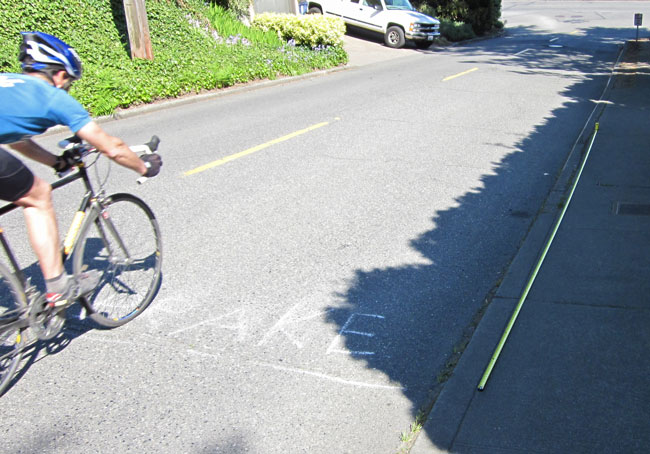
How Hard Can You Brake?
Very, very hard. With rim brakes, we found that to get the shortest stopping distance, we had to pull the front brake lever with all our might. Witness the tester’s bulging muscles on his right arm – which controlled the front brake on this bike.
This is despite using very powerful short-reach Dual-Pivot rim brakes. Some hydraulic disc brakes require less force at the lever, but with rim brakes, you really need to pull very, very hard on the lever.
When we came to a stop, the smell of burnt brake pads wafted through the air. After 21 full-on stops, the Aheadset of the test bike had developed play, because the stem had slipped on the fork steerer. Even the quick release of the front hub had loosened. Braking hard is a very violent affair. Not once did our front wheel lock up.
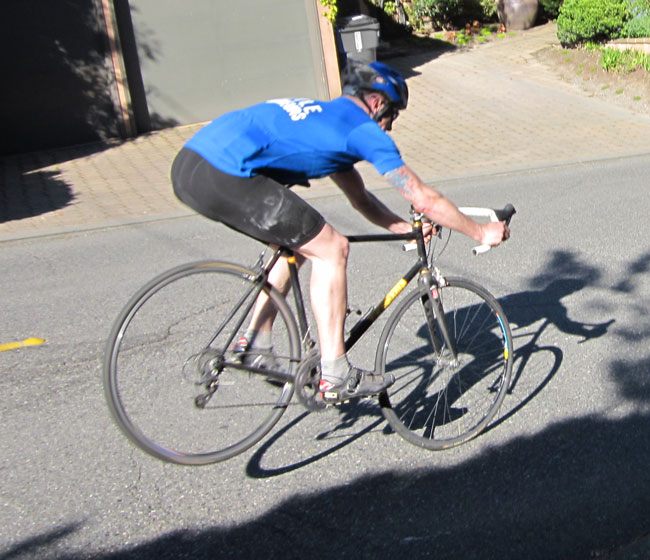
Going Over the Bars
Many riders are afraid of “going over the handlebars” when braking hard with the front brake. They fear that the braking force will cause the bike to rotate around the front wheel. In practice, we found that even on a steep downhill, the rear wheel stayed planted for most of our braking. At speed, wind resistance pushes the rider backward.
Once we had slowed to less than 6 mph (10 km/h), the rear wheel tended to rise. In the photo above, you can see how the front wheel has stopped, while the (unbraked) rear still is spinning. The rear wheel came up slowly. This was not dangerous: The rider simply opened the front brake slightly to make it come back down.
The shortest braking distances were obtained when we slightly decreased our braking power just before we came to a stop, so the rear wheel stayed on the ground.
Few riders ever brake this hard. How come some cyclists go over the bars? Here is what appears to happen in those cases: If riders don’t brace themselves against the handlebars, their momentum pushes them forward. (Imagine being a passenger in a car without seatbelts as the driver brakes hard.) The rider flies forward. Their legs hit the handlebars, and the bike flips over. Basically, the rider flies forward first, and they get tangled in the handlebars. Then the bike flips over.
To avoid this, look at the photos above: Our test riders brace themselves against the handlebars and locks their elbows. They have shifted their weight as far back as possible. You can see their bicycle’s saddle underneath their belly. With this technique, you almost can’t “go over the bars.” And if the bike’s rear wheel does lift, it happens slowly enough that you can counter it by slightly releasing the front brake lever.
Conclusion
We found that we could brake much harder than we thought. Car companies have found the same thing: Drivers tend to be too timid when braking in emergencies. Many modern cars are equipped with “brake assists” that apply the brakes with full force during emergency stops. (ABS makes sure the wheels don’t lock up.)
On bicycles, the “brake assist” and “ABS” are quite literally in our hands. Fortunately, instead of having to manage four brakes during an emergency stop, we can focus on the front brake alone.
Without electronics to assist us, we can benefit from practicing braking hard. (In fact, the same applies to your car, where practicing braking will make you a safer driver.) Practice on an empty road, preferably on a downhill where you can reach higher speeds. Start slowly and brake harder each time, until you are confident to pull on the brake levers very hard. You will be surprised how quickly your bike can stop! And in an emergency, this can make the difference between stopping safely and running into something.
Further reading:
- For more information about how bikes really work, check out our book The All-Road Bike Revolution — How to Make Your Bike Fast, Comfortable and Reliable.


